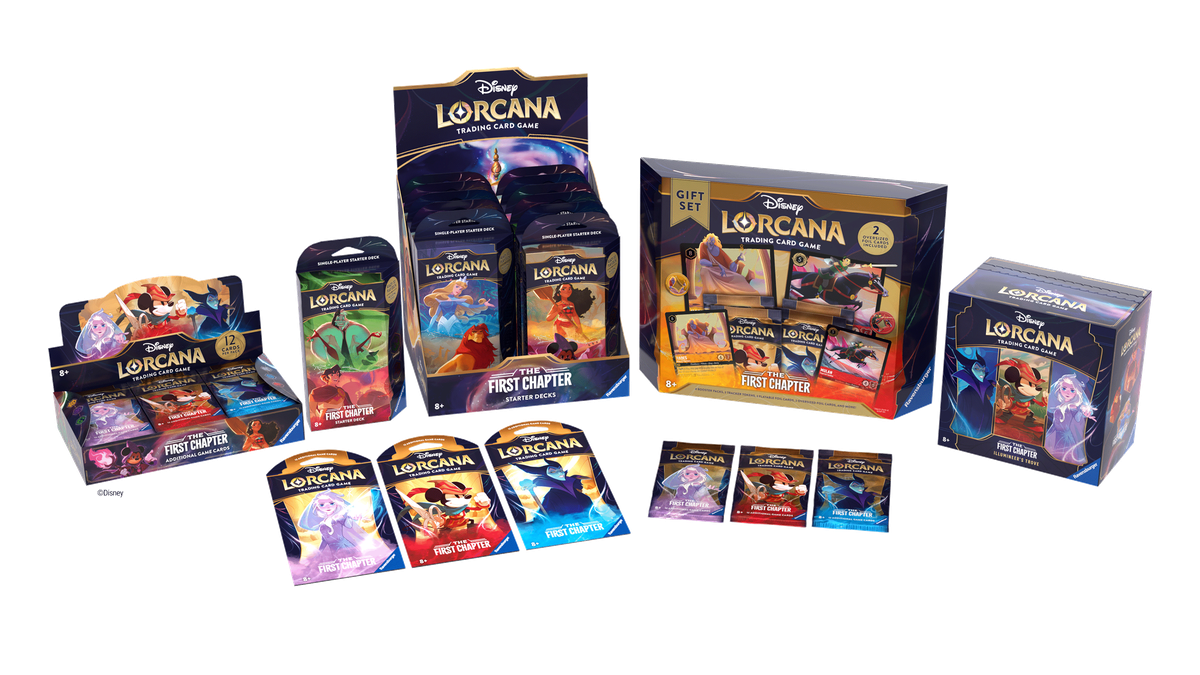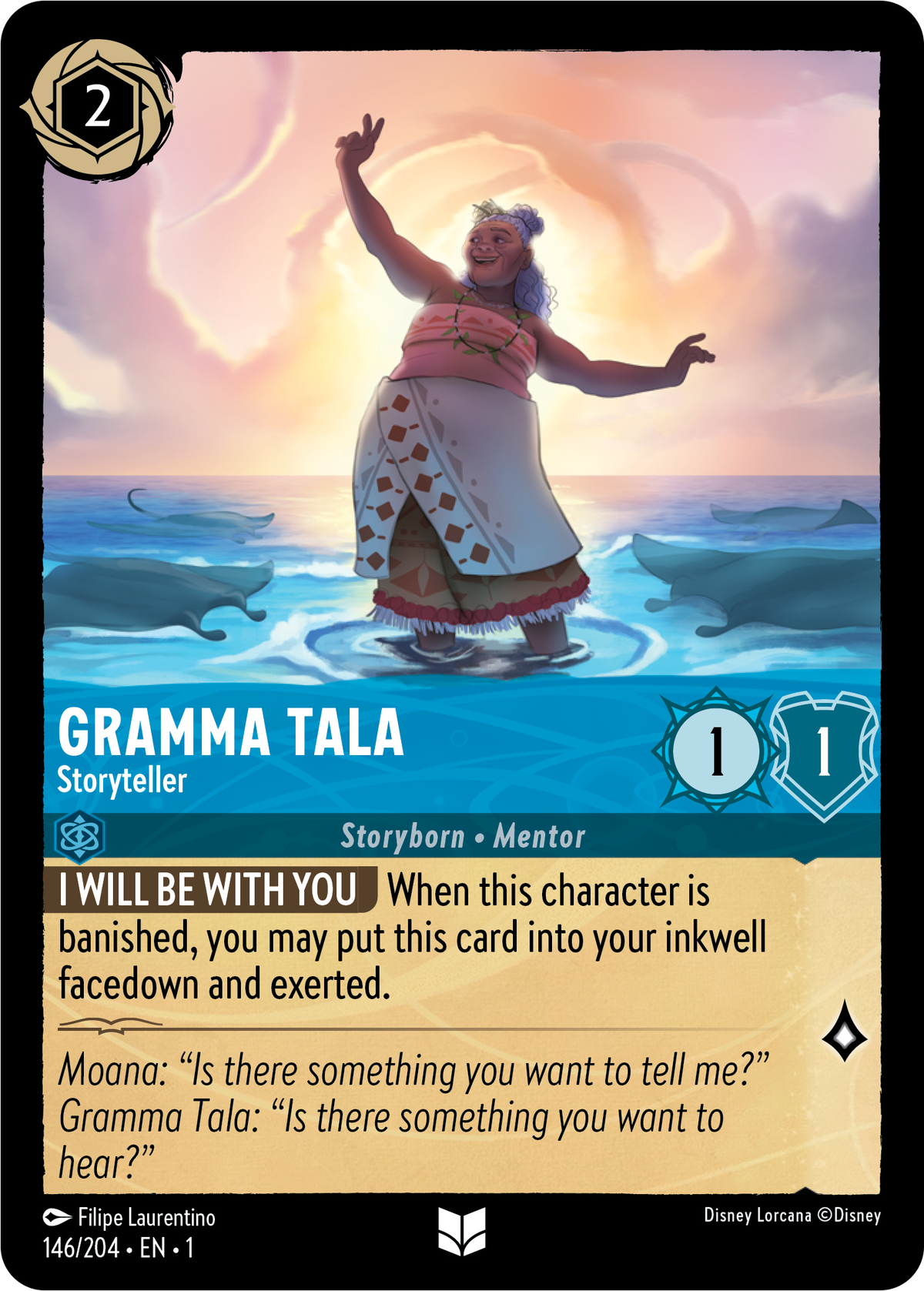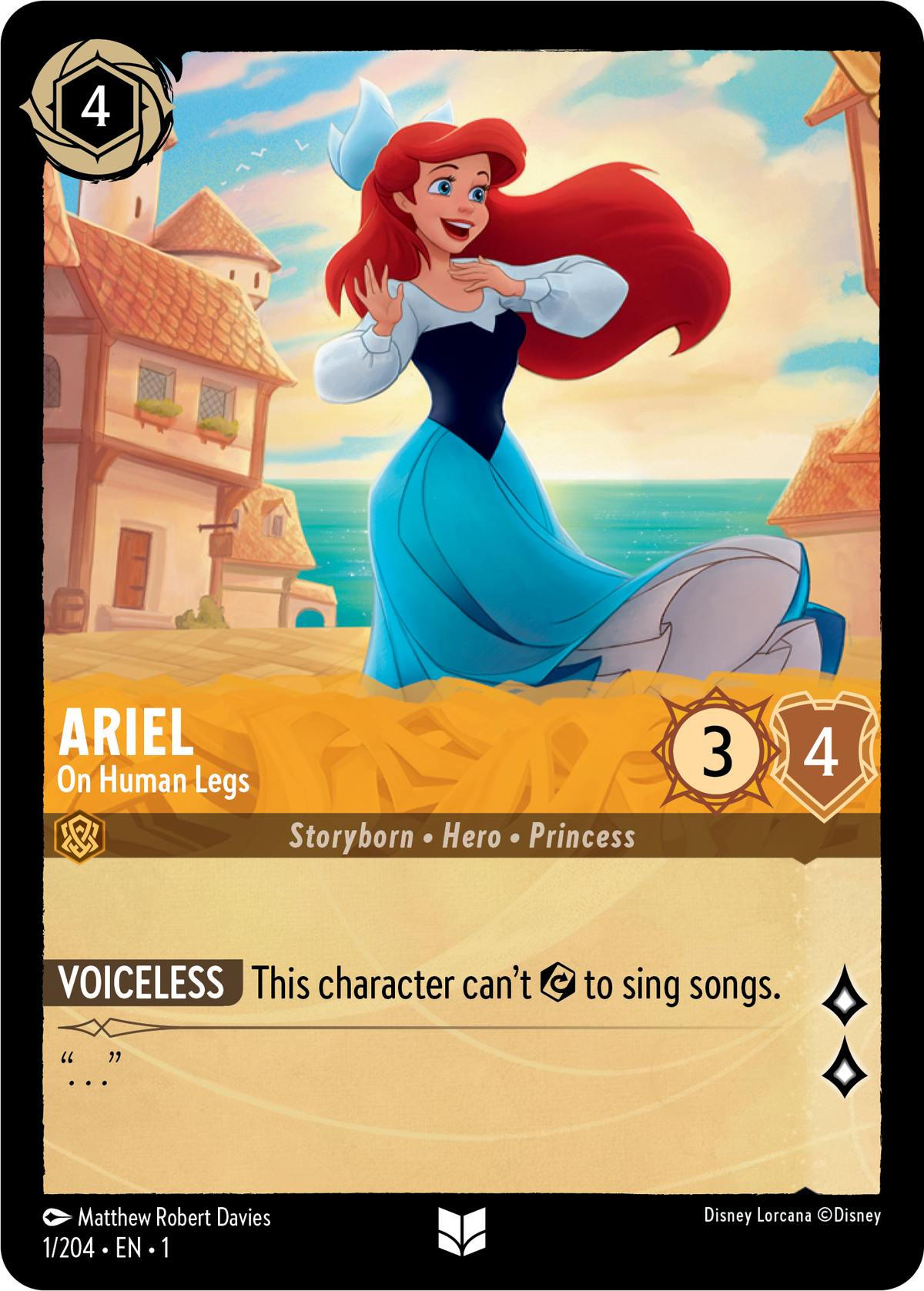Disney Lorcana, the new trading card game from German-based Ravensburger, walks a fine line as it attempts to attract experienced card and tabletop gamers, while also offering an accessible introduction for casual players, younger fans, or Disney aficionados new to TCGs altogether.
Lorcana frequently blends recognizable Disney themes with straightforward yet strategic gameplay. Based on several sessions with some of Lorcana’s preconstructed starter decks, the game has clear potential for scaling engagement; there’s ample room to dive into meticulous, competition-fueled deck building, or maintain a more casual approach focused on the simple joy of taking your favorite Disney characters on magical adventures.
In Lorcana, players assume the role of Illumineers with the power to use magical ink to summon Glimmers, the game’s versions of Disney characters and items. Unlike with Magic: The Gathering or Yu-Gi-Oh!, Lorcana players aren’t racing to reduce an opponent’s life total. Rather, the object of the game is to collect 20 lore points by sending characters on various adventures.
One crucial mechanic discourages players from simply siloing themselves off in their own adventures, and prevents opponents passing like ships in the night: Lorcana features its own version of combat, in which players can use their characters to “challenge” opposing Glimmers in order to remove them from play and slow down lore collection.

Image: Ravensburger/Disney
Other non-character cards can impact lore collection or challenges, including one-time-use action cards or magical item cards that can remain in play for multiple turns. Just as the character cards depict Disney’s iconic heroes and villains, action and item cards will feature their own familiar imagery, such as the wildebeest stampede from The Lion King or Aladdin’s scimitar.
Likewise, the whole game is driven by a resource system called ink, which functions a lot like Magic: The Gathering’s system of mana. Players “exert” their ink cards, or turn them sideways, to pay the ink cost of characters, actions, and items. But unlike mana, ink doesn’t come from its own unique card type. Instead, players can place certain cards face-down on the board to serve as ink for other cards.
In effect, Lorcana’s system is somewhat reminiscent of Flesh and Blood’s method of “pitching” cards to pay costs, except the ink sticks around for subsequent turns. This opens the door to new decisions every turn, with constant card evaluation. Is a given card more valuable as ink, or whatever is printed on the front? Sometimes, using the wrong card for ink can create a ripple effect and define the rest of the game. But this system also reduces the feel-bad stretches of having cards stuck in your hand because you haven’t drawn the resources to play them. In Lorcana, you’re basically never short of potential ink.
One of the most interesting qualities of Lorcana’s gameplay, especially in the late-game stages when players have enough ink to play multiple cards per turn, is its free-for-all nature of sequencing game actions. If you have ink to spend, items to activate, or characters on the board, you can perform legal actions in basically any order.
This, again, does the double duty of enhancing both the game’s accessibility and potential complexity. On one hand, players don’t have to memorize different steps or phases that dictate when actions can be taken. If it’s your turn and you want to perform a certain action, chances are, you can do it right now.

Image: Ravensburger/Disney
On the other hand, this flexibility eventually rewards the more disciplined players who consider the benefits of various sequences to maximize the interplay between cards: synergies that can earn you more lore, challenge opposing creatures more efficiently, or simply get more actions out of a finite amount of ink.
Part and parcel with the mechanics and systems of Lorcana is the sheer Disney-ness of it all. There are myriad Easter eggs and nuanced card mechanics for Disney fans to pick up on, but in many cases, the thematic inspiration for certain characters and movie props leaps off the cardboard. Card effects that impact the game in strategic ways do so while depicting unmistakable moments from the beloved films.

Image: Ravensburger/Disney
One touching example can be seen on a card depicting Gramma Tala from Moana. Early in the film, Tala dies, but her spirit takes the form of an ethereal manta ray who follows Moana on her journey across the Pacific Ocean. In Lorcana, Tala’s character card features a unique ability called “I will be with you,” which turns her into an ink card when she would normally be banished from gameplay, keeping her in play as a resource for the player’s other cards.
Another example concerns The Little Mermaid’s Ariel, after she’s traded her voice for legs. As an homage, the character card features an ability called “Voiceless,” which prevents her from singing songs. In Lorcana, songs are a subset of action cards that can be played by exerting characters instead of ink, and offer a variety of effects, such as card draw or bouncing characters back to their owner’s hand. While practically any character card can be used for songs, which frees up ink to use on other cards, Ariel’s deal with Ursula, and the resulting consequences, leads to a debuff, of sorts, that nonetheless feels appropriate for the source material.
For some players, the tie-in to Disney themes might be this game’s main attraction — but it could likewise be the biggest hurdle for people who don’t like or simply don’t care about the films and characters. Though Lorcana’s gameplay offers plenty of strategic depth for thoughtful and challenging gameplay, it bears enough similarities to other TCGs that some players may be hard-pressed to pick it over Magic, or other proven card games that aren’t built on preexisting fandom.

Image: Ravensburger/Disney
Ultimately, Lorcana will have to both become a collector’s item and convince players of its competitive potential if it’s going to coexist with other mainstays in the TCG space. Ravensburger has already confirmed that Lorcana will support a system of organized play, though specific details remain uncertain. For now, players can look forward to some kind of tournament system, based out of local game stores, which will lead to “league points” toward prizes such as special cards, pins, and the like.
Ultimately, Lorcana probably isn’t a Magic killer — but maybe it doesn’t have to be. Instead, the fandom-oriented nature of this game’s art and themes might actually position it to compete more closely with the Pokémon Trading Card Game. While the latter benefits from its own rich history in the TCG space, it too features characters that players recognize from cartoons, toys, and games. As a result, there might be less resistance among Pokémon fans to try another card game that levies players’ relationship to an existing IP. Perhaps most importantly, Lorcana is very easy to learn and play right out of the box.
Disney Lorcana will debut with its first set of 204 cards, known as The First Chapter, on Aug. 18 at local game stores and Disney Parks, followed by a wider release on Sept. 1 at mass retailers.
The initial release will include three different starter decks, each with 60 ready-to-play, curated cards plus a handful of tokens for tracking lore and damage. Lorcana will also be available through 12-card randomized booster packs, and other bundles such as gift sets and the Illumineer’s Trove, which includes booster packs, deck boxes, and additional accessories.
Disney Lorcana was reviewed using a pre-release copy provided by Ravensburger. Vox Media has affiliate partnerships. These do not influence editorial content, though Vox Media may earn commissions for products purchased via affiliate links. You can find additional information about Polygon’s ethics policy here.

















































